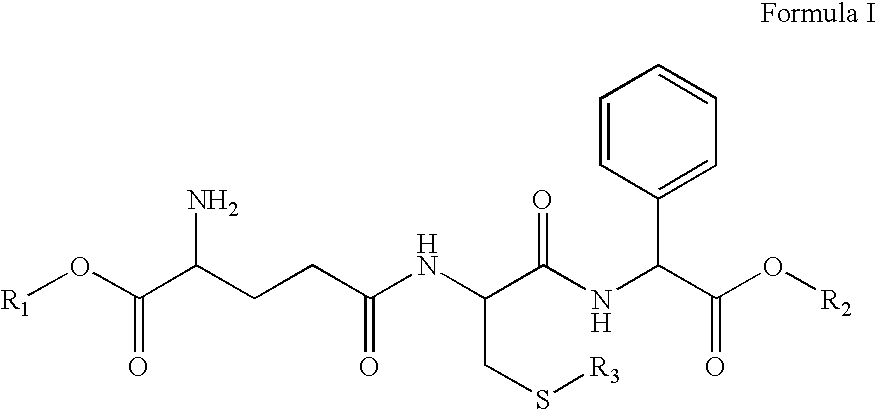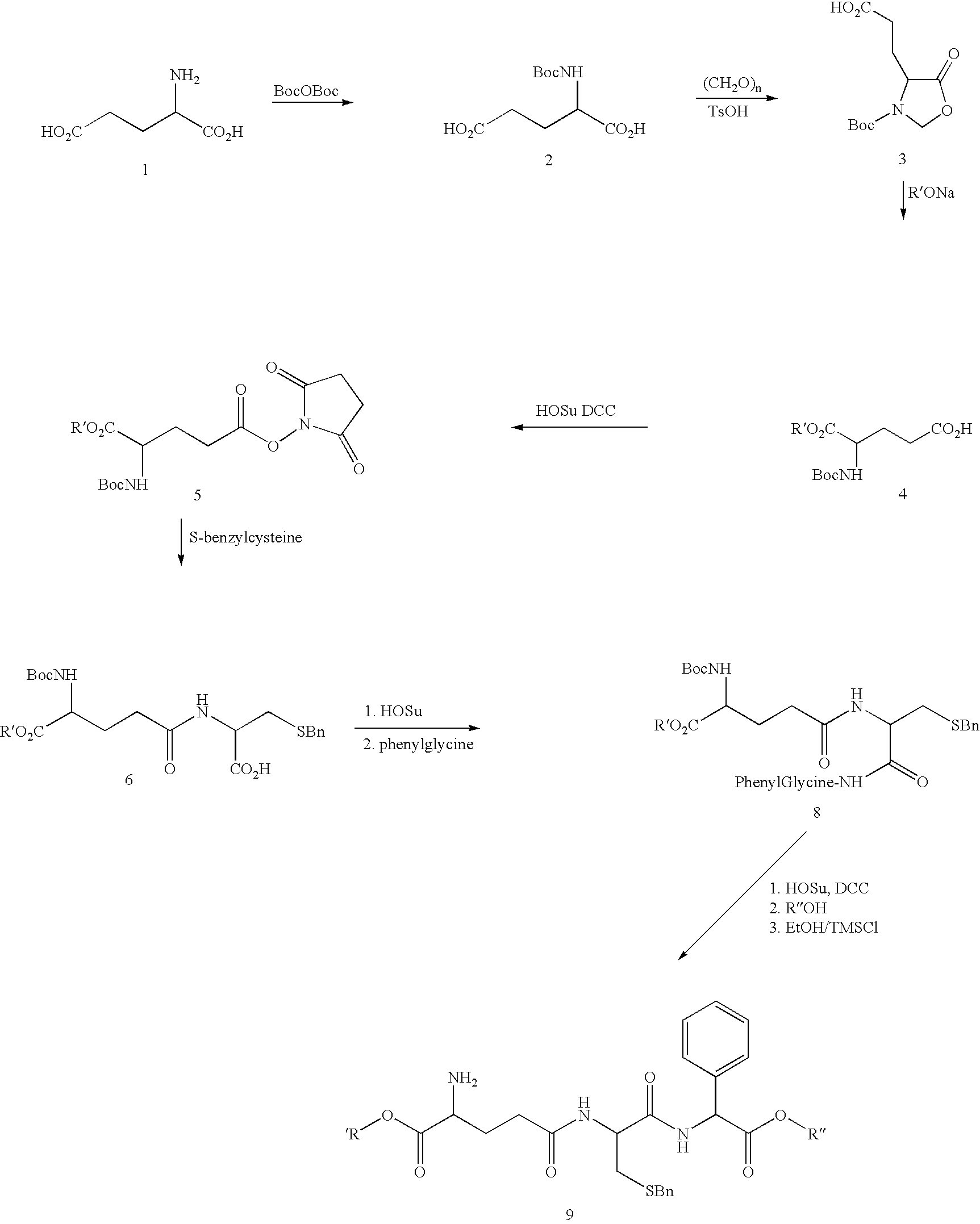Therapeutic compositions containing glutathione analogs
a technology of glutathione analogs and therapeutic compositions, applied in the field of glutathione analogs, can solve the problems of limiting the efficacy of cancer therapy, putting the subject at serious risk of infection and uncontrolled bleeding, and little practical remediation for these effects, and achieve the effect of efficient encapsulation in epc/epg
- Summary
- Abstract
- Description
- Claims
- Application Information
AI Technical Summary
Benefits of technology
Problems solved by technology
Method used
Image
Examples
example 1
Preparation of Glutathione Analogues
[0051]L-Glutamic acid 1, is protected using di-t-butyldicarbonate under basic conditions. Compound 2 is then cyclized to give the oxazolidinone 3 through the reaction of paraformaldehyde, and a catalytic amount of
[0052]
Intermediate 7 (N-a-t-Boc-a-ethyl-g-glutamyl-S(benzyl)cysteine succinimide ester) is not shown in the reaction scheme above.
[0053]p-toluenesulfonic acid. Compound 4 is prepared by the reaction of the oxazolidinone and R′ONa. The succiminide ester 5 is prepared with DCC coupling with N-hydroxysuccinimide and the g free acid 4, which is then reacted with S-benzyl-L-cysteine for the formation of the protected dipeptide 6. The succinimide ester is prepared through a DCC coupling and its reaction with phenylglycine yields the protected tripeptide, 8. Deprotection and esterification leads to final product 9.
example 2
N-α-t-Boc-L-glutamic Acid, 2
[0054]Two 500 g portions of L-glutamic acid (6.8 mols) were suspended in 4 L of 10% THF in water each. Na2CO3 powder was added to pH 9 resulting in a clear solution. Each solution was heated to 40° C. (for the first 10 hrs during the addition of the Boc anhydride) and 1 kg of di-t-butyl dicarbonate (4.58 mols) was added as a solid in 50 g increments to each flask every 30 min. while the pH was maintained at 9 by addition of Na2CO3. The reaction was stirred overnight at room temperature. The following day, an additional 1 kg of di-t-butyl dicarbonate was added as above. On the morning of the third day each solution was extracted twice with two 2 L each of EtOAc (It was found that the formation of the butanol stopped the reaction after the addition of 1 eq of the Boc anhydride and that the extraction with EtOAc removed it and increased the yield significantly). The aqueous layer was collected and 1 kg of di-t-butyl dicarbonate was again added as above (heat...
example 3
Preparation of Lipid Microspheres
[0065]30 mg of 9, 10 g of purified soybean oil, and 1.8 g of purified yolk lecithin were added, and the mixture was melted under heating by means of a homogenizer. Then 2.21 gm of glycerol and enough distilled water to bring the volume to 100 ml(approximately 90 mL) were added, followed by a rough emulsification by means of a homogenizer. The product is then further emulsified by means of a manton gaulin type homogenizer. The solution is then passed through a 1.2 μm filter to afford a final emulsion of approximately 220 nM particles at 300 μg / mL. In a similar manner, lipid microspheres containing compounds 10 to 12 are prepared.
[0066]
TABLE 2Measured Characteristics of Lipid MicrospheresIncorporation ofcompound inParticleLipid ParticleSizeFraction of 1.2Decrease of K1Conc.Mean ± SDμm-filterin esteraseCompound(mg / mL)(nM)passing (%)hydrolysis 90.1–193.70.609100.03–3 220.7 ± 106.396.8-1-5.90.45411 1–3219.6 ± 76.0 90.6–91.30.185120.3222.3 ± 76.4 91.9
[0067...
PUM
| Property | Measurement | Unit |
|---|---|---|
| vesicle size | aaaaa | aaaaa |
| size | aaaaa | aaaaa |
| size | aaaaa | aaaaa |
Abstract
Description
Claims
Application Information
 Login to View More
Login to View More - R&D
- Intellectual Property
- Life Sciences
- Materials
- Tech Scout
- Unparalleled Data Quality
- Higher Quality Content
- 60% Fewer Hallucinations
Browse by: Latest US Patents, China's latest patents, Technical Efficacy Thesaurus, Application Domain, Technology Topic, Popular Technical Reports.
© 2025 PatSnap. All rights reserved.Legal|Privacy policy|Modern Slavery Act Transparency Statement|Sitemap|About US| Contact US: help@patsnap.com



